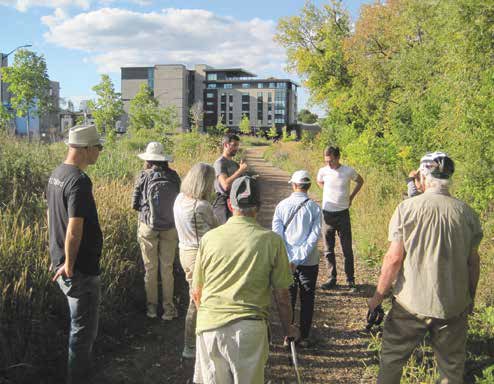John Dance
So where can you find half a kilometre of Rideau River naturalized property in the heart of the City of Ottawa that everybody values yet nobody wants to own? The answer is becoming all too clear: the Rideau River Nature Trail and its adjacent multi-use pathway through Greystone Village in Old Ottawa East.

The future of the corridor running along the Rideau River and through Greystone Village is unknown; both the City of Ottawa and the Rideau Valley Conservation Authority have declined ownership of the land. Photo by John Dance
The initial impetus to naturalize the popular 30-metre-wide waterfront corridor running from Clegg Street to Springhurst Park came from Sustainable Living Ottawa East (SLOE) and was reflected in the Old Ottawa East community design plan and then the secondary plan. Greystone Village developer, Regional, embraced the idea and funded the related landscaping. Regional made clear from the outset, however, that it did not want ongoing ownership and maintenance responsibility for the corridor.
Neither the City of Ottawa nor the Rideau Valley Conservation Authority is interested in owning the property.
“The corridor is contaminated, and the extent of remediation required for the City to assume the corridor is more than what was financially feasible,” says Douglas James, the City’s Manager, Development Review.
Despite not wanting to own the property, the City has two easements that run through the corridor, one for the multi-use pathway and the other for the massive sewer line that runs beneath. The City approved a $15.8 million grant to Regional so that it could clean up contaminated soil, work that was necessary for the development to proceed.
However, there was no funding provided for cleaning up the corridor’s contaminated soil. Regional “capped” the contaminated soil in a fashion similar to what the City has done with its Alta Vista Transportation Corridor lands beside Springhurst Park so that the contaminated soil does not pose a health risk unless it is disturbed.
Lots of ifs and buts
Recently, a dozen SLOE members and Greystone Village residents had a walkabout of the waterfront corridor with a view to assessing how the naturalization of this greenspace was working out. In the resulting report, written by former SLOE chair Rebecca Aird, the overall perspective is that “To a large extent, the resulting landscape is very successful.” And as Ian McRae, SLOE’s tree expert, says, “The site is naturalizing nicely despite the challenges of trampling and drought. Many of the first trees planted are doing well.” But there are lots of ifs and buts.
“[I]n many places aggressive and unappealing weed species are increasingly dominant,” the report notes. “A key question is where to actively maintain open grassland/meadow versus allowing tree ‘succession’ to proceed. Also, where a canopy will form, how much energy should go into controlling invasives in the meantime, and to removing “volunteer” trees.”
“But no matter who assumes maintenance responsibility, it makes sense to minimize the financial and labour investments needed for the long-term success of this naturalized landscape,” says the report. “That means understanding and working with ‘natural’ tendencies. Over the last few years, a volunteer ‘invasives brigade’ has worked hard to remove invasives along the Greystone corridor and other stretches of the Rideau River Nature Trail, but there are limitations to how much can be done by volunteers.”
Other identified issues include how to keep users on the single intended path to protect the soils and the vegetation. Also, the woodchips on the footpath have largely decomposed or washed off the path so options include annual replenishment of the wood chips or replacement with stone dust. The impact of dumping salt-laden snow onto the corridor also was a considerable concern because only ragweed seems to grow in the contaminated soil. The report recommends replacing the contaminated soil and ending the snow-dumping practice. Evan Garfinkel, Regional’s land manager says, “We are aware that snow plowing contractors inadvertently stored snow in the corridor last year. Both City/private contractors were advised that snow was not permitted to be stored in the corridor and as a result it was removed promptly afterwards. We have delivered the same message to contractors this year that snow storage is not permitted within the environmental corridor.”
Given Regional’s insistence that it does not have ongoing responsibility for the corridor, SLOE is proposing two complementary options.
Two proposed options
SLOE’s report says, “One alternative that has been proposed is to mount a campaign to convince the Rideau Valley Conservation Authority, the National Capital Commission and the City that an innovative partnership is needed in order that the whole shoreline beginning at Strathcona Park (Sandy Hill) and extending to Linda Thom Park (Old Ottawa South) is treated as a single park of significant ecological and recreational importance in Ottawa.”
The second option is a community land trust. “This would only make sense if an endowment could be established that would generate sufficient annual revenue for ongoing maintenance needs,” says the report.
“Further research and study would be needed to determine what an adequate budget would be. But given that Regional is currently paying about $15,000 in annual taxes on the shoreline land, an ask for a significant contribution to a community land trust endowment may not be so farfetched.”
After reviewing SLOE’s report, Regional’s Garfinkel responded, “This winter, Regional will be reviewing a strategy to address these unplanned footpaths where planting had occurred and any additional remaining deficiencies from the approved landscape plans.
While we greatly appreciate all of the feedback and ownership that the community association has taken, it is important to remind everyone that the vision for the corridor was always to let it ‘grow wild’ and become naturalized. We would be happy to meet with the community later in the winter once we have reviewed and finalized our remaining landscaping works.”
Derrick Crossman, one of the participants in the walkabout and a Greystone Village resident, has a more critical perspective on the situation: “I assume Regional is profiting from their acquisition of the Oblates property, but since the buffer zone is a non-revenue generating asset (although they use it in their marketing material) they want to walk away from it and hope the community takes over responsibility. They need to be good corporate citizens and step up and maintain their property.”
![]() Residents who are interested in helping with the removal of invasives along the river shoreline or getting involved with the future of the river corridor should email Sloe@ottawaeast.ca. The full report on the river corridor is available at: https://ottawaeast.ca/sloe
Residents who are interested in helping with the removal of invasives along the river shoreline or getting involved with the future of the river corridor should email Sloe@ottawaeast.ca. The full report on the river corridor is available at: https://ottawaeast.ca/sloe
.






